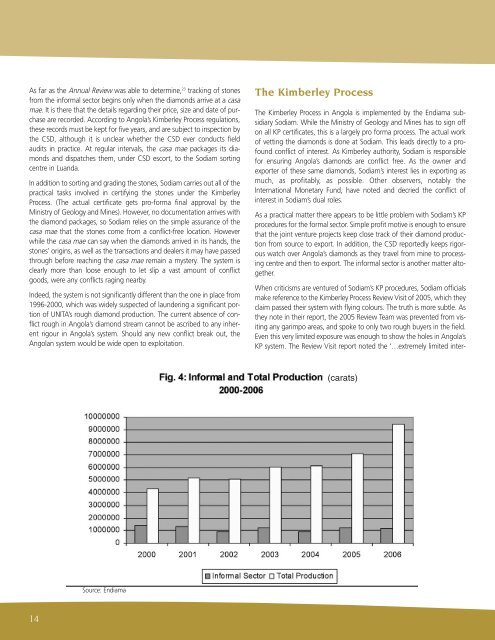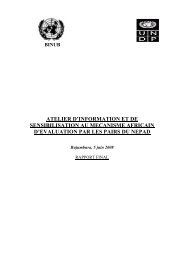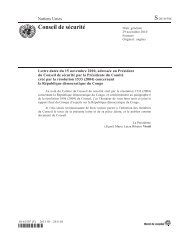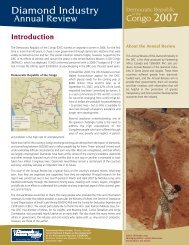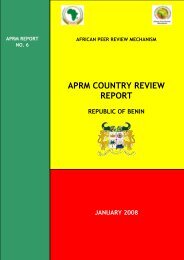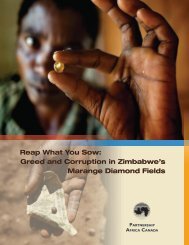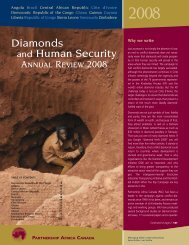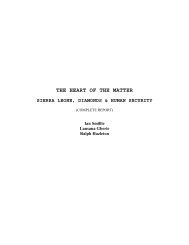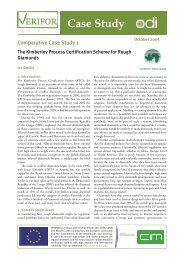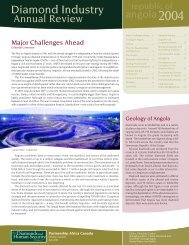As far as the Annual Review was able to determine, 23 tracking of stonesfrom the informal sector begins only when the diamonds arrive at a casamae. It is there that the details regarding their price, size and date of purchaseare recorded. According to <strong>Angola</strong>’s Kimberley Process regulations,these records must be kept for five years, and are subject to inspection bythe CSD, although it is unclear whether the CSD ever conducts fieldaudits in practice. At regular intervals, the casa mae packages its diamondsand dispatches them, under CSD escort, to the Sodiam sortingcentre in Luanda.In addition to sorting and grading the stones, Sodiam carries out all of thepractical tasks involved in certifying the stones under the KimberleyProcess. (The actual certificate gets pro-forma final approval by theMinistry of Geology and Mines). However, no documentation arrives withthe diamond packages, so Sodiam relies on the simple assurance of thecasa mae that the stones come from a conflict-free location. Howeverwhile the casa mae can say when the diamonds arrived in its hands, thestones’ origins, as well as the transactions and dealers it may have passedthrough before reaching the casa mae remain a mystery. The system isclearly more than loose enough to let slip a vast amount of conflictgoods, were any conflicts raging nearby.Indeed, the system is not significantly different than the one in place from1996-2000, which was widely suspected of laundering a significant portionof UNITA’s rough diamond production. The current absence of conflictrough in <strong>Angola</strong>’s diamond stream cannot be ascribed to any inherentrigour in <strong>Angola</strong>’s system. Should any new conflict break out, the<strong>Angola</strong>n system would be wide open to exploitation.The Kimberley ProcessThe Kimberley Process in <strong>Angola</strong> is implemented by the Endiama subsidiarySodiam. While the Ministry of Geology and Mines has to sign offon all KP certificates, this is a largely pro forma process. The actual workof vetting the diamonds is done at Sodiam. This leads directly to a profoundconflict of interest. As Kimberley authority, Sodiam is responsiblefor ensuring <strong>Angola</strong>’s diamonds are conflict free. As the owner andexporter of these same diamonds, Sodiam’s interest lies in exporting asmuch, as profitably, as possible. Other observers, notably theInternational Monetary Fund, have noted and decried the conflict ofinterest in Sodiam’s dual roles.As a practical matter there appears to be little problem with Sodiam’s KPprocedures for the formal sector. Simple profit motive is enough to ensurethat the joint venture projects keep close track of their diamond productionfrom source to export. In addition, the CSD reportedly keeps rigorouswatch over <strong>Angola</strong>’s diamonds as they travel from mine to processingcentre and then to export. The informal sector is another matter altogether.When criticisms are ventured of Sodiam’s KP procedures, Sodiam officialsmake reference to the Kimberley Process Review Visit of 2005, which theyclaim passed their system with flying colours. The truth is more subtle. Asthey note in their report, the 2005 Review Team was prevented from visitingany garimpo areas, and spoke to only two rough buyers in the field.Even this very limited exposure was enough to show the holes in <strong>Angola</strong>’sKP system. The Review Visit report noted the ‘…extremely limited inter-(carats)Source: Endiama14
Republicof<strong>Angola</strong> <strong>2007</strong>nal controls…’, as well as the fact that for informal production,‘ …theprovenance of the diamonds was also not checked or verified in anyform…’ .In view of this, the KP review team made the following recommendations:1. <strong>Angola</strong> should submit to the Kimberley Process a comprehensivereport on internal controls in the artisanal alluvial mining sector;2. <strong>Angola</strong> should ensure that the diamond-buying offices purchaserough diamonds only from individuals with credentials and that allrecords of transactions are kept regularly, including the provenance ofdiamonds;3. <strong>Angola</strong> is called upon to invite a follow-up review visit in due courseand provide access to artisanal alluvial diamond producing areas toensure compliance with the established control mechanisms in thatsector.To date, <strong>Angola</strong> has made no move to implement any of these recommendations.At the time of the Review Visit, the team opted to overlook these shortcomings,accepting the assurances of <strong>Angola</strong>n officials that the governmentwas in the process of putting an end to the informal sector altogether.Operation Brilhante, the large scale operation aimed at removingillegal foreign diggers from <strong>Angola</strong>, was then in full swing, and the assurancesseemed at least plausible.A look at government’s own production statistics (see Figure 4) shows justhow ineffective the government’s anti-garimpo measures have proven.Production in 2000, years before any of anti-garimpeiro measures began,was a little over 1.4 million carats. The influx of new formal projects, completewith private security, as well as Operation Brilhante, resulted in twosmall dips in production, to 898 thousand carats in 2002, and 892 thousandcarats in 2004. However, by 2006, despite years of concerted effortby army, police and immigration, <strong>Angola</strong>’s garimpeiros were once againdigging out 1.2 million carats a year, slightly more than the seven yearaverage, and more than the total alluvial production of Sierra Leone, theCentral African Republic, Tanzania and Brazil combined.The government’s failure to stamp out the informal sector is in part areflection of <strong>Angola</strong>’s diamond geology. Increased enforcement measureshave put an end to garimpeiro activity in numerous areas, particularlythose in close proximity to formal alluvial diamond projects. However, aspolice and private security guards have forced garimpeiros out of themore easily accessible areas, they have simply moved to other, more distantsites, on the rivers bordering the Congo in Lunda Norte, in Moxicoprovince to the south, and in the province of Bié, in many ways <strong>Angola</strong>’snew diamond frontier.The other factor contributing to the government’s failure is the widespreadcorruption afflicting <strong>Angola</strong>n society. Operation Brilhante certainlysucceeded in removing large numbers of Congolese (and other WestAfricans) from <strong>Angola</strong>n diamond fields, as protests from the DRC bearwitness. However, in the years since, many of these Congolesegarimpeiros have filtered back to the diamond fields of <strong>Angola</strong>.The Annual Review notes this corruption not to embarrass <strong>Angola</strong>n government,but to emphasize the fact that informal production will not disappearin the <strong>Angola</strong>n hinterland simply because ministers in Luanda willit to do so. Possibly, as formal concessions expand, the most promisingareas will all come to be occupied, and the rate of informal productionwill decline. Even so, it will never reach zero. At a best guesstimate, it willlikely stabilize at some substantial value, perhaps a half or three-quartersof a million carats per year.As presently constituted, the <strong>Angola</strong>n Kimberley system has no way oftracking those diamonds back to source. The obvious failings in <strong>Angola</strong>’sKimberley controls should be cause for concern in the wider Kimberleycommunity. There are, after all, more than a million carats per year exiting<strong>Angola</strong>, all of it with the murkiest of credentials. More troubling still,there is nothing in the <strong>Angola</strong>n KP system that would prevent the wholesalelaundering of rough diamonds from conflict zones in or out of<strong>Angola</strong>, should a new conflict break out.<strong>Angola</strong> urgently needs to find a way to track and regulate this production.Managing Informal ProductionAccording to sources in Endiama, the <strong>Angola</strong>n authorities have finally recognizedthe futility of trying to stamp out the informal sector, and havebegun to seek ways to incorporate garimpeiros into the formal system.In April, <strong>2007</strong>, <strong>Angola</strong>n President Jose Eduardo dos Santos created a newhigh-level committee, the Interministerial Commission for the Protectionof <strong>Diamond</strong> Resources, 24 or CIPRED, with participants from all of <strong>Angola</strong>’ssenior ministries. According to sources in Endiama, much of the committee’sefforts will be directed towards dealing with informal productionand garimpeiros.One of the options being considered is a return to the provisions outlinedin the 1994 <strong>Diamond</strong> Law, by which a limited number of garimpeiroswould be licensed to work on those parts of a diamond concessiondeemed commercially unviable. Over time, licensed garimpeiros would beencouraged to invest some of their profits in small scale mechanizationAlthough there are challenges to such a scheme, it is certainly worth considering.As currently envisioned, the responsibility for designating thegarimpeiro areas, buying the garimpeiro production and facilitating theshift to mechanization would all fall to the concession holder.Unfortunately, concession holders consulted by the Annual Review wereloathe to involve themselves in any way with garimpeiros. As a substitute,Endiama could consider creating its own specialized small scale miningdivision, which might be called Endiama Mineração de Pequeno Porte(Endiama MPP).A new Endiama division like this could work with concession holders todetermine optimum areas in which licensed garimpeiros could work.Endiama MPP could take on an advisory role, teaching garimpeiros aboutappropriate technologies (such as the portable mining jig that is in exten-15


